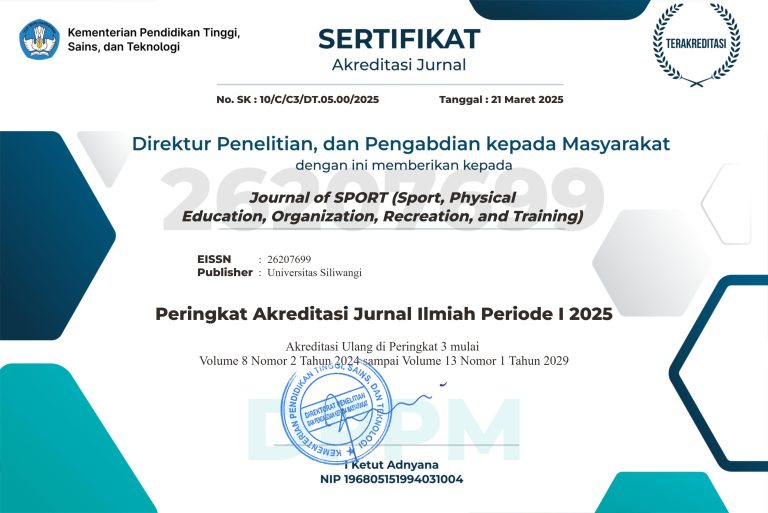Efektivitas Latihan Dry Land dan Mobility Terhadap Kecepatan Renang 50M Gaya Bebas Usia 17-18 Tahun
Abstrak
Penelitian ini bertujuan untuk membandingkan efektivitas latihan dry land dan latihan mobility dalam meningkatkan kecepatan waktu tempuh atlet. Metode yang digunakan adalah eksperimen dengan dua kelompok perlakuan. Hasil analisis menunjukkan bahwa kelompok dry land mengalami penurunan waktu tempuh sebesar 1,66 detik (5,44%), sedangkan kelompok mobility hanya sebesar 0,65 detik (2,18%). Latihan dry land yang melibatkan kekuatan, pliometrik, dan kecepatan terbukti mampu meningkatkan daya ledak otot, efisiensi neuromuskular, serta koordinasi gerak tubuh. Sementara itu, latihan mobility cenderung berfokus pada peningkatan fleksibilitas dan pencegahan cedera, namun kurang efektif dalam peningkatan kecepatan. Standar deviasi posttest yang lebih kecil pada kelompok dry land juga menunjukkan peningkatan konsistensi performa antar atlet. Temuan ini menegaskan bahwa latihan dry land lebih unggul dalam meningkatkan performa kecepatan dan direkomendasikan sebagai program utama dalam pembinaan atletik, sedangkan latihan mobility berperan sebagai pelengkap.
Kata Kunci
Teks Lengkap:
PDFReferensi
Arsoniadis, G. G., Chalkiadakis, I., & Toubekis, A. G. (2024). Concurrent Sprint Swimming Interval and Dryland Training: Performance and Biomechanical Variable Changes within a Mesocycle. Applied Sciences (Switzerland), 14(6). https://doi.org/10.3390/app14062403
Behm, D. G., Blazevich, A. J., Kay, A. D., & McHugh, M. (2016). Acute effects of muscle stretching on physical performance, range of motion, and injury incidence in healthy active individuals: A systematic review. Applied Physiology, Nutrition and Metabolism, 41(1), 1–11. https://doi.org/10.1139/apnm-2015-0235
Crowley, E., Harrison, A. J., & Lyons, M. (2017). The Impact of Resistance Training on Swimming Performance: A Systematic Review. Sports Medicine, 47(11), 2285–2307. https://doi.org/10.1007/s40279-017-0730-2
Crowley, E., Harrison, A. J., & Lyons, M. (2018a). Dry-land resistance training practices of elite swimming strength and conditioning coaches. Journal of Strength and Conditioning Research, 32(9), 2592–2600. https://doi.org/10.1519/JSC.0000000000002599
Crowley, E., Harrison, A. J., & Lyons, M. (2018b). Dry-land resistance training practices of elite swimming strength and conditioning coaches. Journal of Strength and Conditioning Research, 32(9). https://doi.org/10.1519/JSC.0000000000002599
Dos’santos, T., Thomas, C., McBurnie, A., Comfort, P., & Jones, P. A. (2021). Change of direction speed and technique modification training improves 180◦ turning performance, kinetics, and kinematics. Sports, 9(6). https://doi.org/10.3390/sports9060073
Đurović, M., Ilić, P., Gračanin, I., Madić, D., & Okičić, T. (2024). Effect of dry-land strength training on swimming performance: A systematic review. Fizicko Vaspitanje i Sport Kroz Vekove, 11(1), 69–85. https://doi.org/10.5937/spes2401069d
Fone, L., & van den Tillaar, R. (2022). Effect of Different Types of Strength Training on Swimming Performance in Competitive Swimmers: A Systematic Review. Sports Medicine - Open, 8(1). https://doi.org/10.1186/s40798-022-00410-5
Hermosilla, F., Sanders, R., González‐mohíno, F., Yustres, I., & González‐rave, J. M. (2021). Effects of dry‐land training programs on swimming turn performance: a systematic review. International Journal of Environmental Research and Public Health, 18(17). https://doi.org/10.3390/ijerph18179340
Jeffreys, I., & Bosak, A. (2018). Guest editorial: Special topic issue, soccer. Strength and Conditioning Journal, 40(3), 1. https://doi.org/10.1519/SSC.0000000000000392
Morouço, P. G., Marinho, D. A., Amaro, N. M., Peréz-Turpin, J. A., & Marques, M. C. (2015). Effects of dry-land strength training on swimming performance: A brief review. Journal of Human Sport and Exercise, 7(2), 553–559. https://doi.org/10.4100/jhse.2012.72.18
Morouço, P. G., Marinho, D. A., Izquierdo, M., Neiva, H., & Marques, M. C. (2015). Relative Contribution of Arms and Legs in 30 s Fully Tethered Front Crawl Swimming. BioMed Research International, 2015. https://doi.org/10.1155/2015/563206
Mubarok, M. Z. (2019). Pengaruh Latihan Small Sided Games Mengunakan Metode Interval Terhadap Peningkatan Dribbling Pemain Sepakbola. Biormatika : Jurnal Ilmiah Fakultas Keguruan Dan Ilmu Pendidikan, 5(02), 144–149. https://doi.org/10.35569/biormatika.v5i02.513
Psycharakis, S. G., Naemi, R., Connaboy, C., McCabe, C., & Sanders, R. H. (2019). Three-dimensional analysis of intracycle velocity fluctuations in frontcrawl swimming. Scandinavian Journal of Medicine and Science in Sports, 20(1), 128–135. https://doi.org/10.1111/j.1600-0838.2009.00891.x
Stone, M. H., Hornsby, W. G., Haff, G. G., Fry, A. C., Suarez, D. G., Liu, J., Gonzalez-Rave, J. M., & Pierce, K. C. (2021). Periodization and block periodization in sports: Emphasis on strength-power training—a provocative and challenging narrative. In Journal of Strength and Conditioning Research (Vol. 35, Issue 8). https://doi.org/10.1519/JSC.0000000000004050
Zaras, N., Apostolidis, A., Kavvoura, A., & Hadjicharalambous, M. (2022). Comparison between Dry-Land and Swimming Priming on 50 m Crawl Performance in Well-Trained Adolescent Swimmers. Sports, 10(4). https://doi.org/10.3390/sports10040052
DOI: https://doi.org/10.37058/sport.v9i3.16517
Refbacks
- Saat ini tidak ada refbacks.
##submission.copyrightStatement##
Journal of SPORT (Sport, Physical Education, Organization, Recreation, and Training)
Program Studi Pendidikan Jasmani
Fakultas Keguruan dan Ilmu Pendidikan
Universitas Siliwangi
Jl. Siliwangi No. 24 Kota Tasikmalaya - 46115
email: penjas@unsil.ac.id
e-ISSN: 2620-7699 ; p-ISSN: 2541-7126

This work is licensed under a Creative Commons Attribution-ShareAlike 4.0 International License.
INDEX BY
1.png)












